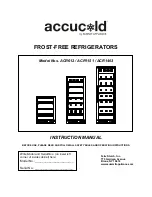
13
Energy Saving Advice
•
Do not install the appliance close to sources of heat, such as a cooker,
dishwasher or radiator.
•
Locate the appliance in a cool well-ventilated room and make sure that the air
vents are clear.
•
Try to avoid keeping the doors open for a long time, warm air will enter the
cabinet and may cause a build-up of ice as well as affecting the energy
consumption. Ensure there are no obstructions preventing the doors from
closing properly.
•
Ensure that the door seals are clean and there are no tears or splits.
•
Keep the most perishable foods, (those with a short shelf-life, such as cooked
meats), in the coldest part of the fridge. The Salad Crisper Box is the warmest
part of your fridge and should be used for vegetables, salads and fruits etc.
•
Do not overload the appliance: the cooling air that circulates to keep the
appliance cold gets blocked and pockets of warm air form.
•
Do not put hot food into the fridge
–
let it cool down first.
•
The shelves are placed in factory mode this delivers the most energy efficient
usage for this appliance.
Refrigerator compartments
Type of food
Door or balconies of fridge
compartment
Foods with natural preservatives, such as jams,
juices, drinks, condiments.
Do not store perishable foods.
Crisper drawer (salad
drawer)
Fruits, herbs and vegetables should be placed
separately in the crisper bin.
Do not store bananas, onions, potatoes, garlic in
the refrigerator.
Fridge shelf
–
bottom
Chiller (box/drawer)
Raw meat, poultry, fish (for short-term storage)
Fridge shelf
–
middle
Dairy products, eggs
Fridge shelf
–
top
Foods that do not need cooking, such as ready-to-
eat foods, deli meats, leftovers.
Food Storage Guidelines










































